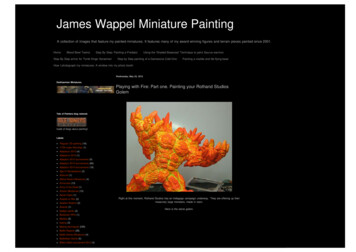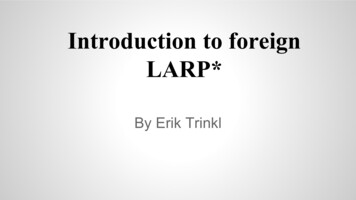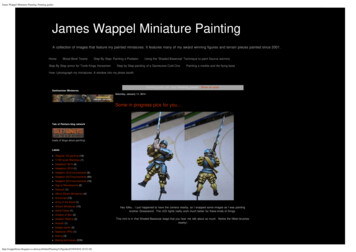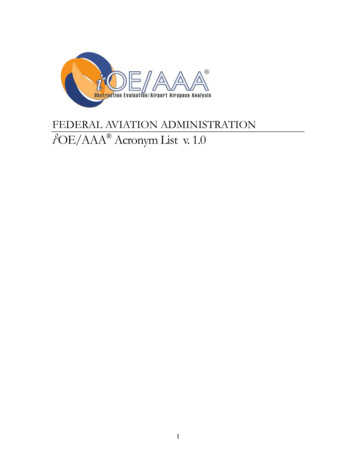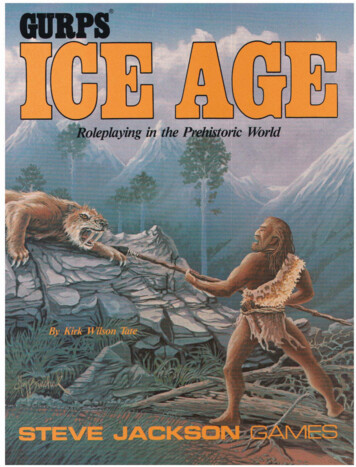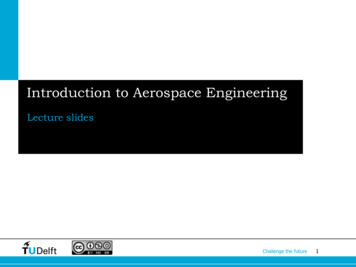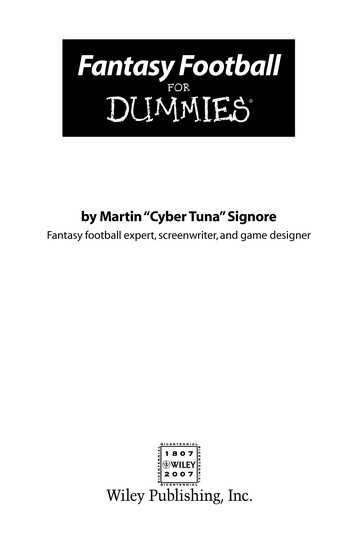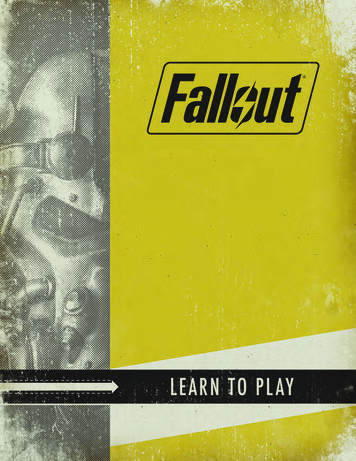
Transcription
NOTICEISSUED BY VAULT-TEC DOCUMENTATIONDEPARTMENT, JANUARY, 2077––This document containsinformation affecting the national defense of the UnitedStates within the meaning of the New Amended EspionageAct, 50 U.S.C., 31 and 32. Its transmission or the revelationof its contents in any manner to an unauthorized person isprohibited by the law.F allout: The Board Game. To make your first game easier, thisbooklet omits some rules exceptions and card interactions. TheRules Reference contains the complete rules of the game andaddresses all special exceptions that are not addressed here. TheRules Reference should be consulted as questions arise whileplaying the game.If you are playing this game by yourself, make sure to read theWelcome to Vault 84, the latest in a series of public defensethis Learn to Play!to the best in nuclear shelters. This document is for the eventsfollowing a worldwide nuclear war. In such a case, this shallwalk you step by step through surviving and eventually thrivingin the irradiated wasteland left outside the confines of yourVault-Tec vault.When you step into the wasteland, you are on your own! Eachsurvivor will need to earn experience, fight dangerous enemies,scavenge, trade, and complete quests to make it out there. At thestart of your journey, you will have nothing but the vault suiton your back. By following this survival guide, you will growin power and wealth quickly and learn to vie for influence withwhatever factions now control the wasteland around you.2This Learn to Play booklet teaches new players how to playINTRODUCTIONworks from Vault-Tec, your contractor of choice when it comesLEARNTO PLAYSURVIVING THEWASTELAND“Solo Play” rules on page 15 of this document after readingTHE CARD LIBRARYMany quest and encounter cardsare labeled with a number in theupper-left corner of the card.These cards form the cardlibraryand are set aside in their own deck duringsetup. This deck will have cards of all types and colorsmixed together. Throughout the game, you may becalled to retrieve a card from this stack by number. It isrecommended that you keep these cards organized bynumber to make this as fast and easy as possible.
COMPONENTS34R ules R eference34 WastelandTHAERILROADWNTOWN ND O O S TOB4 Scenario Sheets21 M ap Tiles21 Settlement75 Encounter C ards20 V ault12 Pegs5 Plastic F igures5 C haracter C ards5 C haracter S.P.E.C.I.A.L. Tokens4 Player Boards8 C onnectorswith3 V.A.T.S. Dice100 Quest Cards14 Perk C ards27 Enemy Tokens35 S.P.E.C.I.A.L. Tokens54 C aps T okens12 Trait Tokens2 Power TokensLEARNTO PLAY334 Loot C ards25 Asset C ards11 U niqueAsset C ards23 Agenda C ards10 F action Tokens8 Q uest M arkers
SET1C hoose Scenario: As a group, choose whichscenario you would like to play. For your firstgame, we recommend playing the scenario“The Commonwealth.” Take the correspondingscenario sheet and place it above the play area.2BuildandtheM ap: Separately shuffle the map tiles, and then construct the map6following the image on the back of the chosenscenario sheet, placing the appropriate faceupmap tiles in the indicated locations and arandom or map tile facedown in eachindicated location.7CROSSROADSCAMP43Sort Tokens: Create piles of the S.P.E.C.I.A.L.,Caps, trait, and enemy tokens, making sure theS.P.E.C.I.A.L. and enemy tokens are facedownand randomized; the enemy tokens should befurther separated into individual stacks by type.4C reate Encounter D ecks: Separate thestarting encounter cards—cards that have a starin the upper-left corner—intotwo different decks based ontheir card backs, shuffle them,and place them facedown inLEARNTO PLAY4the play area.StartingencounterTake the remaining encounter cards and thequest cards and put them in numerical order.This is the cardlibrary(not shown).DIA
TUPAM5C reate O ther D ecks: Remove all cards from theagenda deck that show a number in the bottomleft corner that is greater than the currentnumber of players. Then, separately shuffle the ), loot ( ), and asset ( ) decks andagenda (place them facedown in the play area. Lastly,make sure the perk cards, unique asset cards, andV.A.T.S. dice are within easy reach of all players.6Create Shop: Deal four asset cards faceup in aline next to the asset deck to form the shop.7C hooseandPlace Survivors: Randomlydetermine a first player and move the agendadeck to his or her right side. Starting with thatplayer and proceeding clockwise, each playerchooses a survivor and takes the correspondingfigure, character card, and S.P.E.C.I.A.L. token94CITRUINmarked with that character’s silhouette onSthe back. Then, the player places the figure inan unoccupied space—one of the individualsections of tile divided by the white lines—in the“Crossroads Camp” tile.ONITDC8YPrepare Player Boards: Each player takes aplayer board and places a green peg in the “0”hole, a red peg in the “16” hole, and a gray peg inthe hole to the left of the XP track. Each player alsoplaces his or her starting S.P.E.C.I.A.L. token in the93THAERILROAslot on the player board with the matching letter,Dthen draws one additional S.P.E.C.I.A.L. tokenat random and places it in its slot; if that player4already has that letter, he or she randomly drawsWNTOWN ND O O S TOBa different S.P.E.C.I.A.L. token instead. Then, eachplayer draws one agenda card, keeping it secretfrom the other players. Finally, each player takesthree Caps.9R esolve Starting Effects: Resolve any effectson the back of the scenario sheet. Then, for eachspace on the map with an icon matching an iconon an enemy token, take one random enemy tokenBackof theScenario SheetTo “stage,” take the card with that number from thecard library and put it into the play area.matching that icon and place it faceup in thatspace (enemies will be described later). Finally,place the and power tokens on the topmostspace of the power track on the scenario sheet.LEARNTO PLAY5
THE GAME ROUNDEXPLORE ACTIONPlayers take turns in clockwise order, starting with the firstNo one is exactly sure what is waiting out there in the wasteland,player. After all players have taken a turn, enemies on the mapactivate and attack, and then a new round begins with the firstbut you’re going to find out! There’s a lot of unexplored territoryout there represented by facedown map tiles, and you can useplayer taking another turn. Players continue resolving roundsthe explore action to find out what mysteries they hold.in this way until a player achieves enough influence to claimEach map tile is divided into spaces, which are defined by whitevictory or one of the factions in the scenario reaches the end ofthe power track.RESOLVING A TURNWhen it's your turn, it’s your time to shine! This is when you getto explore the wasteland, fight dangerous enemies, and completequests.During your turn, you may perform up to two actions. You canborders. If you are in a space with a border touching a facedownmap tile, you can perform the explore action to flip the map tilefaceup. Then, orient the tile so that the arrow on the top of thetile is pointing the same direction as the arrow on the startingmap tile.After revealing a new map tile, if there are any enemy icons onthe map tile, draw a random enemy token of the matching typeand place it faceup in that space.perform the same action multiple times. After you complete youractions, your turn ends, and the next player takes his or her turn.2You can perform the following actions:CROSSROADSCATKEOCDR NR E AT I OSTMP Explore: Reveal an adjacent facedown map tile. Move: Move your figure around the map. Quest: Complete one of the available quests. Encounter: Draw and resolve an encounter card accordingto your position on the map. Fight: Fight and attempt to kill an enemy in your space. Camp: Recover some HP, unexhaust your companions, andThe Wastelander explores an adjacent facedownmap tile , revealing the R ed R ocket S tation .exchange stuff with other survivors.All actions are described in detail in the following sections.YOU, THE SURVIVORCROSSROADSCAMP2TKEOCDR NR E AT I OSTWhen this Learn to Play uses the word “you,” it refers toboth the player who is resolving his or her turn and thesurvivor that he or she controls. The survivor and the playerLEARNTO PLAY6are inseparable. This player is also referred to as the “activeplayer” by some cards and rules.The tile is oriented with the white arrow.Then, a enemy is placed faceup on the tile.
MOVE ACTIONTERRAINYou use the move action to (you guessed it) move around theSome spaces have terrain that affects a survivor who moves intomap! But be careful; the wasteland is hazardous, and there isrough terrain and plenty of radiation awaiting you.When you perform a move action you gain two movementthat space. The terrain is indicated by the color of the space's border: Difficult (red): You mustspend two points of movementpoints. You can spend each point to move your figure into anadjacent space. You may interrupt your move action to performyour second action, and after you are finished performing thisto move into this space. Irradiated (green): You suffersecond action, you may finish performing your move action.one rad (Additionally, if you perform two move actions during your turn,into this space (rads arethe points of movement from both actions can be combined anddescribed later).HHW4Y7 ) when you movespent together (see the “Move Action Example” below).11174WYABSHURDYRMOVE ACTION EXAMPLE1The Vault Dweller performstwo move actions, gainingfour movement points. He2PSUERDUPMAERspends the first point to moveRT1into the adjacent space.3REAIDARCMP22He spends his second andthird movement points tomove into a space that hasdifficult terrain.3final movement point to33He spends his fourth andmove into a space that hasirradiated terrain; so heONLETN D AT EEP STEsuffers 1 rad.3OBCRO ORYTCFALEARNTO PLAY7
QUEST ACTIONCARD RESULTSTo gain influence inWhen a quest is completed, it can have several effects onthe wasteland, youthe game. These effects are listed in a shorthand shown in aare going to have tohelp other people,O bjectiveswhether it be someresults bar under a given objective on the card.random wastelandersor one of the powerfulfactions determinedR esults Barby the scenario. Allof the ways youResolve these effects left to right, as follows:can help people areR esultsrepresented by quests.All quests availablelibrary. Then, take a number of cards equal to the numberQuest C ardfor you to complete are staged faceup in the play area. Onequest is staged this way during setup, and then others are addedas you play the game. Each quest has multiple objectives,each with different results. Each objective has its own uniquerequirements. Some might provide a name of a space or type ofspace on the map that your figure must be in, others might listspecific actions you must perform.Some objectives are marked with a icon, indicating that youmust perform a quest action to complete that objective. After youhave fulfilled the requirements of such an objective, if there are noenemies in your space, you can perform a quest action to completethat quest.If an objective does not have a icon, you complete the questaction is necessary!When a quest is completed, you resolve all effects listed in theresults bar presented below the objective you fulfilled (see “CardResults” sidebar to the right).card's back. Finally, shuffle all the cards together andplace them on top of the matching deck. Stage #: Search the card library for the card indicatedby # and place it faceup in the play area with theother quests. # XP: Gain the amount of XP indicated by #(described later). # Caps: Gain the number of Caps indicated by #.number, such as x 2, draw that number of cards. Gain the X unique asset: Search through the unique Shop #: Buy or sell a number of items from the shopdetermined by # (described later). or : The faction corresponding to the iconmarker, choose a pair of quest markertokens with a matching color. Place one onshown gains an amount of power equal to the numberthe map as indicated by the quest and thecard is trashed, discard both quest markers.back matching the icon shown. If the icon is followed by ahas already been taken, draw one unique asset at random.If a quest instructs you to place a questother on the quest card itself. When that , , or : Draw a card from the deck that has aasset deck for the card specified by X and take it. If that assetQUEST MARKERS8of players from the top of the deck matching the retrieved Become X: Take the trait token matching X.automatically when you fulfill the objective’s requirements; noLEARNTO PLAY Add #: Retrieve the card indicated by the # from the cardof symbols after the icon (described later).Q uest M arkers Trash: Return this card to the game box. If the questis not trashed, it is left in the play area and can becompleted again.
ENCOUNTER ACTIONRESOLVING ENCOUNTERSThere’s a wholeTo resolve an encounter, the player to your right draws onelot of nothingR eadT heseout there sincethe war, but keyencounter card and reads the italicized text at the top of the cardaloud. Then, he or she reads the bold text at the start of eachnumbered option, including any tests or requirements. Then, youchoose which option you would like to resolve, and the playerlocations still havereading the card prompts you to perform any listed requirementspre-war artifactsfor that choice; these may include performing tests, fightingand gatherings ofsurvivors that haveW ait toR eadT heseformed towns inthe interveningcenturies. You canenemies, or paying Caps.If you succeed at all requirements, the other player reads all textfollowing the “Succeed” header under that option. If you fail tomeet all requirements, the other player reads all text followinghave encounters tohunt around in thethe “Fail” header under that option. Finally, you resolve allEncounter C ardeffects listed in the results bar for the appropriate outcome (seewasteland, trade with people at settlements, or investigate vaults.“Card Results” sidebar on the opposite page). After completing anIf you are in a space marked with an encounter icon (shownencounter, place that card on the bottom of its deck.below), you can perform an encounter action to resolve anencounter card from the deck matching that encounter icon. Youcan encounter each location only once per turn, and you cannotperform this action if you are in the same space as an enemy.PERFORMING TESTSMany encounters and quests require you to complete a test.ENCOUNTER ICONSEach test shows one or more S.P.E.C.I.A.L. tokens followedThere are two encounter icons at the start of the game:test, you roll the three V.A.T.S. dice and count the number by a difficulty number; for example:Wasteland Encounter: Cards in the wastelanddeck allow you to scavenge the location for usefulloot or search for things in the wasteland. 4. To perform theof hit ( ) icons shown on the dice results. If the numberequals or exceeds the difficulty of the test, you succeed!If you have any S.P.E.C.I.A.L. tokens that match those usedby the test, you can reroll any number of dice before the finalSettlement Encounter: Cards in the settlementresults of the test are resolved. You can perform one such rerolldeck allow you to buy and sell things from the shopfor each S.P.E.C.I.A.L. token that matches one used by the test.track and search for things in settlements.There are also two vault-encounter icons: and . However,the vault-encounter cards are not added to the game until youcomplete specific quests. Until the vault-encounter cards are addedto the game, you cannot have an encounter at a vault location.TEST EXAMPLE1prompted to testnumber that indicates its level. When the result bar shows an or ) in place of a number, treat thatencounter icon (as being equal to the level of the encounter icon you are at.For example, if you are resolving an encounter at the level 2Red Rocket station and the encounter reads "would draw two loot cards. x ," you 4. Herolls the V.A.T.S. dice and getsENCOUNTER LEVELEach encounter icon on the map has a correspondingThe Brotherhood Outcast isthree icons. Not enough tosucceed.2He has the token, so hechooses any number of diceto reroll. In this case, just thedie showing no . His newroll gets the fourth heneeds to succeed!LEARNTO PLAY9
SHOP: BUYING AND SELLINGWhen performing an encounter at a settlement, you will oftenCAPS!get the chance to sell items, buy items, or recruit companionsCaps are the widely acceptedfrom the shop. When this happens, draw one card from the top ) deck and add it to the left side of the shop. Theof the asset (encounter specifies a number; this is the maximum number ofitems that you can buy and sell. For example, if the encounterreads “shop twice,” you could buy two assets, or buy one assetand sell one asset, or sell two assets.currency out there and can begained by scavenging and sellingstuff from wasteland locations.Each player tracks his or herpersonal supply of Caps using Capstokens. When you gain Caps, take thatmany Caps tokens from the supply, and when you spendTo buy an asset, spend a number of CapsCaps, return that many to the supply. There are Caps tokensequal to the cost in the upper-right cornerworth both “1” and “5.” Feel free to make change as needed!of the asset card. Some cards, such ascompanions, show a token or trait in thecorner in place of a cost. You can take suchI tem C ostcards only if you have the indicated token or trait.To sell an item, discard it from your inventory to the appropriatediscard pile and gain Caps equal to one less than the item's cost.After you are finished buying and selling, discard or draw newasset cards until there are four cards in the shop. If you have todiscard cards, discard them from the right side of the track. Ifyou have to add new cards, draw them from the asset deck andadd them faceup to the left side of the track.INVENTORY AND EQUIPMENTWhen you acquire an item or companion, place it in your play area; it is now in your inventory. You can have up to three assetsin your inventory at the same time. If you would ever acquire cards in your inventory beyond three, you must choose anddiscard cards until you have only three.EquipmentLEARNTO PLAY10I nventoryAdditionally, you can have up to three cards equipped at a time—one apparel , one weapon , and one companion ,indicated by the slots on your player board. Equipped cards do not count toward your inventory. You can change out whatcards you have equipped when you acquire a new card, at the start of your turn, or when you perform a camp action.
FIGHT ACTIONNext, you inflict hits! Each filled-in area on the dice indicates theWe’re not going to sugarcoat it: it’s dangerous out there. Therean area that matches one or more of the enemy's vulnerabilities,part of the enemy you can potentially hit. For each die showingare mutated creatures, raiders, and worse things waiting for ayou inflict one hit. Each die can hit only one area. If the number ofbright-eyed survivor to come along. You are going to need to behits equals or exceeds the enemy’s level, you kill it!prepared to fight off these enemies.When you kill an enemy, you gain XP (described later) equal toYou can perform a fight action to choose one enemy in yourits level and discard the enemy from the map; it is returned tospace to fight.the supply. Then, you take a random enemy of the same typefrom the supply and place it facedown on the closest matchingicon on the map that does not already have an enemy of thatN ameTypeLevelAbilitiesV.A.T.S.VulnerabilityEnemy TokenWhen you fight an enemy, you are trying to score a number ofhits on it equal to or exceeding its level while avoiding gettinghit back. You can hit the enemy’s head, arms, legs, or body, butonly hits against an area in which the enemy is vulnerable count!To fight an enemy, you roll all three V.A.T.S. dice. Some weapons,which are described later, allow you to reroll your V.A.T.S. dice. icons showing on the V.A.T.S. dice after theroll is final, the enemy hits you! For each icon, you sufferIf there are anydamage equal to the enemy’s level.HP AND RADSWhen you suffer damage, move the red peg on your playerboard a number of holes down the track equal to theamount of damage suffered. Similarly, when you suffer rads( ), move the green peg up the track a number of holesequal to the rads suffered. If the red peg is ever in a lowerhole than the green peg or would be in the same hole as thegreen peg, you are killed!When you are killed, place your figure in any space onthe “Crossroads Camp” map tile, discard all cards in yourinventory, keeping any equipped cards, and recover all HPby moving the red peg back to the highest number on thetrack. When you are killed, you do not recover rads. Aftertype on it. While an enemy is facedown, it is inactive.During a fight, if you do not kill the enemy, it remains in itsspace. Your hits do not carry over from fight to fight. The nextsurvivor to fight that enemy will have to start over.INACTIVE ENEMIESInactive enemies are facedown on the map. You cannotfight or use an ability to target an inactive enemy, and theydo not stop you from performing actions in their space.When a specified type of enemy activates at the end of theround (described later), all inactive enemies of that type areflipped faceup and become active.WEAPONS AND APPARELThe weapons and apparel you have equipped can help youduring a fight.Each weapon has one or moreS.P.E.C.I.A.L. tokens shown on its card.For each of these S.P.E.C.I.A.L. tokensWeapon Statsthat matches a S.P.E.C.I.A.L. token youhave, you can reroll any number of dice before the final results ofthe fight are resolved. You can perform one such reroll for eachS.P.E.C.I.A.L. token that matches one on your equipped weapon. ) icon, whichAdditionally, weapons can have the ranged (allows you to fight enemies that are in spaces adjacent to you.When you fight an enemy that is in an adjacent space that does notalso have a icon, you automatically inflict one additional hitLEARNTO PLAYagainst that enemy when resolving the fight.you recover your HP, if you are still killed because your radsThe apparel you have equipped can provideare in the highest hole, you lose the game and are eliminated.you with armor, which is shown as a value in11the armor ( ) icon. When resolving a fight, you cancel a number of icons on the dice equal tothe value of armor you have equipped.Armor
ENEMY ABILITIESEnemies can have abilities that alter a fight, shown as icons ontheir token: Aggressive: When this enemy moves into your space,or you move into its space, you immediately fight it;this fight is not an action. Armor: This enemy requires one additional hit to kill.Loot: When you kill this enemy, draw one loot card.R adiation : When this enemy hits you for any amountthis, turn the card 90 degrees on its side. An exhausted cardcannot be exhausted again. When instructed to unexhaust acard, turn it 90 degrees to be upright again.When a companion unexhausts, check the condition listedon the bottom of its card. If you do not meet this condition,that companion is discarded.Ranged: When this enemy activates (described later), it canfight you from an adjacent space. If it does this, and you do weapon, add one to the dice results.R etreat: If you fail to kill this enemy during a fight,the enemy becomes inactive and is flipped facedown.FIGHT EXAMPLE1Some cards must be exhausted to use their abilities. To doof damage, suffer rads equal to the enemy’s level.not have a EXHAUST ANDUNEXHAUSTThe survivor fights a Raider Psycho in her space. Sherolls the three V.A.T.S. dice.UnexhaustedExhaustedCAMP ACTIONDoes all of this have you exhausted? When the wasteland isbecoming too much for you, find a safe place to hunker down,recover a bit, and trade with your fellow survivors.When you perform a camp action, you recover three HP andunexhaust all of your exhausted cards. Then, you gain the WellRested trait by taking the Well Rested trait token and placing iton your player board (traits are described later). Finally, you may2The survivor has an equippedRipper, and since she has the token, she chooses to rerolltwo of the dice. Good choice!3LEARNTO PLAY124You cannot perform this action if you are in the same space asan enemy.She has better results after rerolling.TRADING WITH SURVIVORSThere areSurvivors can trade assets, loot, agendas, and Caps. When you showing, so the Psycho hits her! Thesurvivor has a Singed Duster equipped, and its oneperform a camp action, you may choose another survivor withinarmor cancels one of the hits. Then, the survivor suffersone space of you and exchange any number of assets, loot,four damage—two for each of the two uncanceled hits.agendas, and Caps. You must both agree to the exchange. YouThe survivor hits the Raider Psycho. She inflicts twohits, one for each die that matches a vulnerable area on and . Since she inflicted hits equal tothe Psycho—the Psycho’s level, the Psycho is killed.5trade with any other survivors within one space of you.The survivor gains two XP and draws a loot card thanksto the icon on the Raider Psycho.can also trade promises of future deeds, though whether or notyou decide to keep those promises is up to you.
END OF THE ROUNDWINNING THE GAMEThere are many dangers in the wasteland, including terrifyingCompleting quests throughout the game can grant you agendaenemies and powerful factions working toward their own goals.cards. These cards track your accomplishments in the wasteland.So far, the survivors have been having all the fun, but at the endEach agenda card is kept secret from the other survivors. Anof the round, these forces get their chance to act.agenda card automatically grants you a single influence ( )and can grant you additional influence if you meet the conditionAfter all players have taken their turns,outlined on the card. Your goal is to reach a certain amount ofenemies activate. You reveal the topinfluence before the other players. You can have a maximum ofcard of the agenda deck and resolve thefour agenda cards in your hand; if you draw a fifth, choose oneenemy icons shown along the bottom ofand shuffle it back into the agenda deck.the card, and then discard it. All text onagenda cards is ignored during enemyThe amount of influence you need to win depends on theactivation—this text is used only if anumber of players in the game:player has drawn it and is described later.Agenda C ardENEMY ACTIVATION 1 Player: 11 influence 2 Players: 10 influenceFrom left to right, for each enemy 3 Players: 9 influenceicon shown on the bottom of the 4 Players: 8 influencedrawn agenda card, that type ofenemy activates. When an enemy typeactivates, you move each enemy ofthat type one space toward the nearestEnemies that ActivateThis R oundsurvivor. If, before moving, that enemy is either in the same spaceas a survivor or adjacent to a survivor and has the icon, theAs soon as the total value of your agenda cards is this amountof influence or more, the game ends and you win! Reveal youragenda cards to the other players. At this time, any other survivorswho also reached or exceeded the required amount of influencecan reveal their cards and claim a joint victory alongside you.enemy fights that survivor instead. After all enemies of a type haveENEMY ACTIVATION EXAMPLEactivated, you flip all inactive enemies of that type faceup.TARR M and the enemyEWhen an enemy fights a survivor, that survivorPDUE R performed a fight action.resolve a fight as if that survivor PhadSU2If there is ever a tie for the closestsurvivor, the enemy movestoward or attacks the survivor with the lowest HP value. If twosurvivors are tied for lowest HP value, the tied player that acts3RAIRDECAMPearlier in turn order is chosen.DRAWING THE LAST AGENDA CARDWhen the last agenda card is drawn, you shuffle the agendadiscard to create the new agenda deck. Then, you pass the deck tothe player to the right of the first player; that player is now the firstplayer. Whose turn it is and whose turn is next does not change.Finally, you advance both faction tokens one space down the trackONon the scenario sheet to represent their power growing over time.Play continues with the next player in turn order. The round willend, and the next agenda card will be drawn, before the new firstplayer’s next turn.3ETDL ENP E S TATELEARNTO PLAY13All and enemies activate. is flipped faceup,revealing a Looter! Then, The inactiveactivate, and the Mole Rat in theWastelander’s space fights her!3OBCRO ORYCTFA
ADDITIONAL RULESTRAITSThere are a few more things you need to know before headingThe choices you make during encounters and quests can haveout into the wastes! The next few sections will tell you aboutlasting effects on you or your reputation in the wasteland. Thesegaining XP, acquiring traits, and the factions you will confrontstory details are tracked by trait tokens.during your adventures.There are six traits tracked across three token types. When youXP AND LEVELINGhave a trait token, you cannot also have the trait displayed on theopposite side.As you kill enemies, have encounters, and complete quests,I dolized/Vilified: These traits track what peopleyou will gain XP and become more powerful . . . and morein the wasteland think of you. If you’re idolized,S.P.E.C.I.A.L.! Each time you kill an enemy, you gain XP equal topeople like you. If you’re vilified . . . well, you get it.that enemy’s level. Other game effects that grant XP will specifySynth/Super Mutant: These traits indicatethe amount gained.whether or not you’re a synth or a super mutant.XP is tracked by your XP peg (gray). The first time you earn anWell R ested/Addicted: These traits track yourXP, you place the XP counter in the hole beneath the farthest-well-being or dependence on the multitude ofleft S.P.E.C.I.A.L. token you have. Each time you earn XP, youdrugs available in the wasteland.move your XP peg to the next S.P.E
4. CIT RUINS. 4. DIAMOND CITY THE RAILROAD DOWNTOWN BOSTON. 3 4. 9 9. LEARN TO PLAY. 5. 5 c. reaTe. o. Ther. d. ecks: Remove all cards from the agenda deck that show a number in the bottom-left corner that is greater than the current number of players. Then, separately shuffle the age
